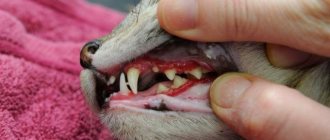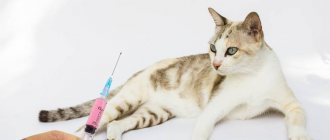What does a lice eater look like?
The cat lice beetle (Felicola subrostratus) is a parasite that lives on the surface of the animal's skin. It is the causative agent of diseases such as mallophagosis or trichodectosis. They feed on keratin particles of skin, fur, secretions of the sebaceous glands, as well as blood that appears from wounds when combing. They are also called chewing lice because, unlike regular lice, they do not suck blood.
Lice eaters in cats resemble lice, which is clearly visible in the photo. They have a small oval body (1-2 mm) and a quadrangular shield-shaped head. They look translucent due to their light gray, yellowish color. Each of the parasite's 3 pairs of legs has hooks that help it cling to hairs and skin. Gnawing type mouth.
Lice eaters do not like to change their owner. The female lays up to 60 eggs and glues them to the hair roots with a special secretion. It is impossible to remove eggs from wool by hand. After 1-1.5 weeks, larvae hatch from the eggs. After another 2-3 weeks, insects appear. How quickly the parasite develops and matures depends on the conditions. So, in winter, when the cat’s undercoat is especially thick and therefore warm, lice eaters develop faster. The entire life cycle of the parasite takes a month.
Outside the host's body, lice eaters live no more than 5 days.
Causes and symptoms of infection
A cat can become infected with lice eaters either from its infected relatives or by catching infected prey: a mouse, a rat, etc. Infection can occur during a walk, and even at home if a person brings the parasites on shoes or clothes.
Symptoms of infection are:
- constant itching and attempts by the animal to “gnaw” insects from the fur;
Severe itching may be a symptom of lice infestation
- scratching on the skin;
- with severe infection and in advanced cases - baldness;
- lethargy, anemia, weakness and irritability;
- inflamed skin, often a rash;
- sometimes insomnia occurs.
Having noticed lice eaters in a cat's fur, it is quite possible to mistake them for fleas. To distinguish lice eaters from fleas, you need to heat the cat's fur (this can be done with a special lamp, near a battery, or simply under the sun's rays). Lice eaters strive for warmth and will crawl to the surface, unlike fleas.
Video: how to tell if a cat has parasites
Routes of infection
A cat becomes infected when adult lice eaters or larvae of lice eaters come into contact with its body. Routes of infection:
- Contact with other animals (cats, guinea pigs).
- Through common household items (bedding, carriers, combs).
- Cats walking outside can become infected from rodents.
- Kittens most often receive parasites from their mother.
There are a number of factors predisposing to the spread of the disease:
- High humidity in the room where the cat lives.
- Many animals are kept in a small area.
- Poor nutrition.
- Weakened immunity.
Prevention of lice-eater infestation
Today, special collars containing insecticides and protecting animals from various ectoparasites are becoming increasingly popular. Such accessories can also be used to get rid of ectoparasites, but in this regard they are not so effective. But they can very effectively repel fleas, ticks, lice eaters and other insects that prefer to live on cats.
To prevent parasite infection, it is recommended to follow the following preventive measures:
- regularly use special anti-parasitic shampoos, sprays or drops, treat the animal’s fur, especially if it walks outside;
- periodically inspect your pet (lice eaters are heat-loving insects, so to see them, you need to place the cat closer to the heat source and wait a little);
- periodically wash the bedding and blankets on which the cat prefers to lie;
- undergo regular examinations at a veterinary clinic.
In addition, if possible, the pet should be protected from contact with infected animals, fed rationally, and properly cared for.
Getting rid of lice eaters is not difficult, and it is necessary to do this if the cat is infected. These insects cause serious discomfort to your pet and can cause various diseases. After treatment, you should thoroughly wash the cat’s bed, house and other things, and treat surfaces in the house with an insecticide (with caution to avoid poisoning animals and small children).
1111
How to identify lice eaters in a cat
It is difficult to immediately determine that a cat is infected. At the first stage, lice eaters in cats show virtually no symptoms, hiding in the lower layer of the undercoat. Select the head and neck area. As their numbers increase, the signs become more obvious. Parasites spread throughout the body.
The owner may suspect that the cat has lice eaters based on the following symptoms:
- The cat is feeling restless and scratching due to itching. Therefore, he is in constant stress.
- Insomnia may occur.
- Scratches are visible when the cat injures itself while scratching.
- The cat's coat thins, becomes dull, unkempt, and dandruff appears.
- Bald patches form in areas where parasites are most concentrated.
Symptoms of infection
Signs of infestation with lice eaters are:
- The cat constantly licks itself, itches furiously, bites into the fur with its teeth;
- When examined, scratches, wounds, and bite marks are found on the cat’s body;
- Areas of the body where hair had fallen out and bald spots appeared.
You should also keep an eye on the cat. Symptoms such as lethargy, loss of interest in games, excessive excitability, and restlessness for no apparent reason may indicate infection with parasites.
The cat's character may deteriorate sharply; it stops responding to the words and actions of the owner. Severe skin itching can greatly spoil an animal's mood and even deprive it of sleep.
The danger of lice eaters for cats
If you suspect lice eaters, you need to immediately begin the fight.
Wool beetles are dangerous for cats:
- They are carriers of worms, most often cucumber tapeworm. As a result, the animal loses weight, eats poorly, and digestion is disrupted. Constipation alternates with diarrhea. Blood may be found in the stool. The cat has a stomach ache.
- They provoke the development of dermatitis and allergies. The itching becomes intense and constant, the skin becomes covered with red bumps and crusts.
- If bacteria enter the areas of scratches and abrasions, an inflammatory process begins. This is accompanied by an increase in temperature, the appearance of pustules, redness and swelling of the skin.
- Lice eaters cause damage to the hair, leading to patchy baldness.
- Chronic diseases are getting worse.
Can humans and other pets become infected with lice from a cat?
The hair-eating tick cannot survive on the human body: it dies from hypothermia on bare skin without fur. However, these parasites are carriers of worm eggs. If a lice eater is accidentally swallowed, a cat, and from it a person, becomes infected with a common tapeworm - the cucumber tapeworm, reaching a length of 70 cm.
It is important to observe hygiene standards: wash your hands with soap after handling animals, clean rooms with chlorine-containing substances, handle trays more thoroughly using rubber gloves, and regularly change the filler.
Treatment
When lice eaters are discovered in cats, treatment is prescribed by a veterinarian, and it depends on the degree of neglect of the problem and the presence of other diseases.
In the treatment of trichodectosis, the same drugs are used as for fleas and ticks. These are mainly drops on the withers, sprays and shampoos, due to ease of use.
Most drugs have a detrimental effect on adults and larvae, but not on eggs. Therefore, the treatment is carried out at least 2 times. In the warm season, the interval between treatments is 10-12 days, in the cold season – 14-18 days.
By all means, you can carry out treatment at home, strictly following the instructions.
Drops
The drugs are produced in the form of “Spot On” - pipettes designed for one-time use. They come in different sizes to make it easier to choose the right weight for your animal. The lice eaters are destroyed within 24-48 hours (depending on the severity of the problem).
The drops are distributed directly onto the skin, so the fur needs to be parted. The place to apply where the cat cannot lick is the area from the back of the head to the shoulder blades.
It is recommended to treat all animals living in the same household. Replace bedding and treat the room.
The table shows the most effective drugs in the form of drops:
| Frontline Spot On Analogues: Fiprin Spot On Dana Spot On | Does not penetrate into the systemic circulation. The active substance accumulates in the upper layers of the skin, sebaceous glands, and hair follicles. Lice eaters die upon contact with liquid. Do not use in cats weighing less than 1 kg and kittens younger than 2 months. Repeated treatment after a month. |
| Advocate | Has a wide spectrum of antiparasitic action. Treatment in animals weighing less than 1 kg is carried out with caution. Cannot be used on kittens under 2 months of age. |
| Stronghold | Having penetrated the bloodstream, Stronghold acts for a month, having a detrimental effect on parasites. The dosage is selected based on the animal’s body weight. Absorbed within half an hour. Already 2 hours after treatment you can wash the animal. Not for use in kittens under 6 months of age. |
| Advantage | Doesn't get into the blood. Penetrates only into the epidermis, hair follicles, sebaceous ducts. Has a detrimental effect upon contact within a month. Prohibited for kittens under 2.5 months. Pregnant cats should only be treated by a veterinarian. The dosage depends on the weight (table in the instructions). Parasites die within 12 hours. |
| Leopard (available in aerosol form) | From ticks, fleas and lice, as well as lice. It is not absorbed into the blood, but accumulates in the epidermis and hair follicles. Can be used in cats from 2 months. The action lasts for 1-2 months. Repeated treatment is carried out no earlier than a month later. |
| IN-AP complex | A complex preparation that kills fleas, ticks, lice, roundworms and tapeworms. Do not use in kittens under 2 months, pregnant or lactating cats. |
| Broadline Spot-On | Available in syringe applicators. It acts comprehensively against external and internal parasites in cats. Effective for up to 42 days. Lice eaters die within 24 hours after treatment. |
Mr. Cat recommends: treatment and care for a sick cat
If you find lice eaters on your pet's fur, you must first show it to a veterinarian. He will examine the cat and determine the type of infection. After this, special means will be prescribed to destroy parasitic insects.
Such drugs contain toxic substances, so they should be used correctly, in recommended dosages. After treating an animal’s fur with an antiparasitic agent, it is recommended to put a special collar on its neck, which will prevent the drug from being licked off and protect the pet from poisoning.
Treatment against lice must be carried out at least twice. Insects lay eggs (nits), which may not be affected by the product. As a rule, adults and larvae die under the influence of the drug the first time.
After about 10 days, the treatment should be repeated to destroy the larvae that have hatched from the eggs, but have not yet reached the adult stage.
If it is not possible to take your cat to the veterinarian, then you can try treatment for lice at home. Parasites can be removed using products sold in pet stores and animal pharmacies.
They are available in the following forms:
- drops (Barrier, Bars, Celandine, Frontline, Hartz);
- sprays (Acaromectin, Bolfo, Frontline);
- special shampoos (Bolfo, Demos Lux, Bars);
- emulsions (Bionix, Merial).
Remedies for ectoparasites can be easily purchased at any pet store, but their use requires great caution. They are toxic and can harm the cat, so when using them you must strictly follow the instructions.
The owner must be especially careful in treating the kitten.
Also, some owners try to cure parasite infestations using traditional methods. They are not as effective as pharmaceutical drugs, but in cases where the disease is detected at the initial stage and there are few insects, they can help. It is recommended to get rid of hairworms using decoctions of plants such as chamomile, string, and wormwood. The cat should be bathed in it.
If there are too many insects and they actively reproduce, then such methods will not have an effect.
If your cat has scratches or lesions on the skin, then after the first treatment with an antiparasitic agent, it is necessary to treat them. The wounds should be washed daily with an antiseptic solution. In cases where the damage is extensive, you can apply a sterile bandage, and then change it regularly after treating with an antiseptic.
Don't let your cat lick its wounds.
In the most severe cases, when damaged skin becomes infected, more serious measures may be required. The doctor may even prescribe a course of antibiotics.
How to treat
The question of how and what to treat an animal when its fur is infested with parasites arises for every owner faced with such a problem. Treatment of lice in cats involves the use of antiparasitic flea drugs, which have a wide spectrum of action. They can be purchased at any veterinary pharmacy in Moscow or a provincial town. Their use makes it possible to carry out treatment at home independently.
Remedies for lice eaters are produced in various variations.
- Spray is one of the most effective preparations, which is created on the basis of insecticidal components. Not only ticks or lice eaters are afraid of him, but also fleas and even lice. The solution is sprayed on the pet's body in the direction opposite to hair growth. It is important to prevent the insecticide from getting into your cat's eyes and mouth.
- Drops against lice for cats have a composition similar to an aerosol product. The medicine is applied to places that are inaccessible for licking (on the spine or withers of the cat).
Drops Bars - Shampoo is a less effective remedy, since it is not always possible to completely cure lice-eaters. However, it is safer to remove parasites with it than with other drugs. This largely depends on the degree of parasite infestation of the pet's fur. Treat the cat's hair with detergent, thoroughly foaming it. Leave for 3-5 minutes, then rinse with running water. The use of this antiparasitic agent requires repeated treatment.
- A collar is another method of removing pests. It is impregnated with an insecticidal solution that is harmful to parasites. The method of application is quite simple - you just need to put the medical accessory on your pet’s neck.
- Tablets intended for internal use help fight various types of skin parasites, including lice-eaters.
- Emulsions - the suspension is diluted in accordance with the description. The resulting solution is rubbed into the cat's skin.
The following brands of veterinary products are especially popular among consumers: Bayer, Bars, Stronghold, Frontline, Bio-Grom, Merial, Irbis, Bionics, Hartz. Whichever of these products you purchase, it is important to follow the manufacturer’s recommendations and follow safety precautions.
Spray Frontline
To get rid of lice in kittens, as well as cats with sensitive skin, it is preferable to use folk remedies. Animals are bathed in a decoction of string, wormwood or chamomile. However, such procedures should be treated in the early stages of infection, and it is better to use them for preventive purposes.
How is the treatment carried out?
If the owner suspects such a problem in his pet, then he should be taken to a veterinarian for examination.
Everyone should know what lice-eaters look like in humans and cats, since the disorder can appear at any time. Since these are not ticks or lice, they will be more difficult to get rid of. If a problem arises in cats, you should contact a veterinarian, who will visually examine the pet and select the necessary medications to help fight lice eaters. When choosing a medicine, a specialist should pay attention to the following factors so as not to harm the animal:
- age group;
- toxic effect of the drug;
- prevalence of lice eaters;
- the presence of chronic diseases;
- sensitivity of the epidermis and the likelihood of allergies.
Sulfur ointment helps to cope with the disorder, which must be regularly applied to the damaged areas. It is equally important to comb your cat, which will help reduce the number of parasites. The table presents the main veterinary remedies that allow you to forget about the presence of lice eaters:
| Medicine form | Name |
| Drops against parasites | "Advantage-40" |
| "Leopard" | |
| "Stronghold" | |
| "Fiprex" | |
| Topical spray | "Bolfo" |
| "Acaromectin" | |
| Flea & Tick-14 Residual Spray | |
| "Delix spray" | |
| "Serko" | |
| "Frontline" | |
| Shampoos | "Demos-Lux" |
| Flea & Tick Cat Shampoo | |
| "Bolfo" | |
| "Shampoo B" | |
| "Rolf Club" | |
| "Celandine" |
A useful tool in the fight against parasites in cats is an emulsion from which a solution is prepared for external treatment. The best, “Agrovetzaschita”, “Merial”, “Impex”.
Alternative treatment: does it make sense?
A decoction of wormwood can be used to bathe an animal.
Since lice eaters are a serious problem in cats, it is difficult to cope with natural remedies alone. This measure can be auxiliary or used in case of an allergic reaction or the inability to use veterinary drugs. You can independently prepare a decoction based on wormwood, string, wild garlic or chamomile inflorescence. The cat is bathed in the resulting product several times. Thanks to the essential components contained in plants, there is a depressing effect on lice, after which it is easier to remove them. Such manipulations are effective in the early stages of pathology.
Biology of the lice eater
The lice eater crawls onto the cat from a rodent, dog or relative. It feeds on loose skin and fur. However, in order to lay eggs, Trichoderma needs complete protein. But where can I get it? She is not capable, like a flea, of piercing the skin and drinking blood. But the lice eater has a powerful gnawing mouthpart.
The movement of arthropods causes severe itching. The cat scratches the skin, and the food is ready: the insect drinks blood at the edge of the scratch and lays eggs. It secretes a sticky liquid and attaches the offspring to the hairs. If the pet lives in a warm apartment, the cycle of transformation from egg to mature individual is 21 days. In an active cat that spends a lot of time outside in winter, the parasite matures in 28 days.
In long-haired pets, due to the many glued eggs, the fur clumps and tangles form, which create ideal conditions for arthropods to grow up. Bacteria and fungi settle on skin defects scratched by a cat, increasing the itching. New scratches provide more and more food for hordes of arthropods and microbes.
Lice eaters ingest cucumber tapeworm eggs, which fall from the anus onto the animal's fur. In the intestine of the insect, the oncosphere is released and develops into a procercoid. When a cat swallows a lice eater, the parasite larva enters the intestine, where it turns into a mature cestode.
A person playing with a cat may accidentally swallow a lice eater and become infected with cucumber tapeworm.
How does infection occur?
In most cases, lice-eaters are transmitted through direct contact of a healthy animal with a carrier animal. Less commonly, infection occurs indirectly, when lice eaters move from one animal to a person or to any other object, and then end up on another pet.
Contact of a healthy animal with an infected one is the simplest way of infection.
The highest likelihood of infection with these lice is in those pets who live too crowded, which leads to frequent contacts between individuals, as a result of which lice-eaters quickly move between carriers and reproduce. This is why lice can often be found on animals taken from nurseries or overcrowded shelters.
The rapid spread of lice-eaters is also facilitated by:
- poor nutrition/lack of it;
- failure to comply with hygiene standards in places where animals gather;
- living on the territory of a shelter, nursery or owner's house of infected rodents that have access to cats.
Due to overcrowding in shelters, animals in them are susceptible to all kinds of epidemics.
As a result of the influence of these three main factors, cats' resistance to this parasite decreases, which is why invasion occurs. Animals with strong immunity, living in comfortable conditions, on the contrary, have a high resistance to lice, even when the latter gets on the cat’s fur.
How dangerous are lice eaters?
These pests can be dangerous to your pet's health because they can cause serious illnesses. Lice eaters can transfer endoparasite eggs to the pet's skin, which leads to helminthiasis. This disease leads to depletion of the cat's body.
A disease such as trichodectosis may also occur, the symptoms of which are not only itching, but also severe hair loss. Due to the damage to the pet's skin by lice eaters, wounds remain on it through which bacteria can enter the cat's blood.
The cat hair eater is not dangerous for people, because the human body temperature is too low for them, and they die from the cold. Lice-eaters are not transmitted to humans, even through direct contact with an infected cat.
Prevention
The following preventive measures exist:
- It is necessary to avoid contact of the cat with other homeless animals;
- Regularly inspect your pet's fur;
- Keep your pet's bedding, house and slicker clean;
- Monitor your cat’s diet and provide him with enough vitamins;
- Every 2-3 months, bathe the cat, and it is advisable to use anti-parasitic shampoo;
- If the cat goes outside, then it is necessary to put an antiparasitic collar on it, which will protect it from lice eaters, as well as from fleas.
Following these simple rules will help avoid the appearance and re-infection of these parasites.
Signs of the disease
You can recognize a parasitic infestation in a pet by its characteristic symptoms. When lice eaters appear, the animal’s behavior and the appearance of its fur changes.
Main features:
- obsessive itching;
- non-healing wounds, redness on the skin;
- peeling, dandruff;
- receding hairline,
- the fur becomes dull and falls out in clumps;
- appetite decreases;
- restless behavior.
The symptoms and treatment of lice eaters in cats, regardless of the breed of the pet, are the same.










